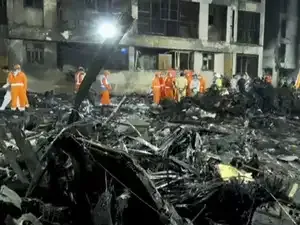For decades, India's defence strategy was predicated on imported military equipment. This dependency exposed India to strategic and financial vulnerabilities. Recognising these risks, policymakers launched a series of reforms to promote self-sufficiency. As a result, domestic production now accounts for about 65% of the equipment used by India's armed forces, marking a significant shift towards self-reliance.
Defence Production Policy 2018 set ambitious goals to make India one of the world's top five aerospace and defence producers. Defence Acquisition Procedure 2020 further streamlined procurement, prioritising indigenous products and making it easier for foreign companies to manufacture in India.
These reforms have fostered a thriving ecosystem by allowing 16 defence public sector units (DPSUs), over 430 licensed private companies, and about 16,000 MSMEs to participate in defence production. India's manufacturing costs are significantly lower than those in Europe or North America, making it a compelling destination for international defence production. The country's large, skilled workforce and rapidly expanding industrial infrastructure have attracted European defence firms, who increasingly outsource manufacturing to India to optimise costs while maintaining quality.
A pivotal moment for India's defence sector has been the battlefield validation of indigenous platforms. In recent conflicts, indigenous platforms performed creditably under combat conditions. The army is now conducting large-scale trials of next-generation technologies - including drones, electronic warfare systems and air defence solutions. This 'war-tested' status boosts global confidence in Indian defence products and is expected to drive further export growth.
India's defence exports have skyrocketed, growing 34x from FY14 to $2.8 bn in FY25. GoI has set a target of $5.9 bn in exports by FY30, with Indian equipment now reaching around 80 countries, such as Brazil, Vietnam and the US. Key exports include artillery guns, hi-tech rifles, supersonic cruise missiles, radars, electronic warfare systems and UAVs.
Notably, companies such as BEL, HAL, Bharat Dynamics Ltd (BDL), and private players like L&T and Tata Advanced Systems are poised to benefit from this export boom due to their proven manufacturing capabilities.
Nato's recent decision to raise its defence spending target to 5% of GDP by 2035 is set to inject hundreds of billions of dollars into the global defence market. Europe has an urgent need to replenish and modernise its arsenals, but years of underinvestment has rendered domestic manufacturing capacity anaemic.
Europe will inevitably have to import armaments and technology to meet new Nato commitments. While the US will remain the primary supplier, Europe is unlikely to turn to China for defence technology, given both political and security concerns. In this context, India's cost-effective, battle-tested and scalable manufacturing base positions it as a preferred partner.
But India's defence sector faces technological gaps in advanced systems, supply chain inefficiencies and bureaucratic delays. Regional tensions and global competition could also disrupt progress. However, ongoing reforms, increased R&D investment and a focus on innovation - such as AI and cyber defence - are helping India overcome these hurdles.
Indian defence firms are already integrating into global supply chains, and deals with France (rocket launchers) and the US (artillery cannons) signal growing Western acceptance. As Europe seeks to diversify suppliers and avoid Chinese technology, India's neutral geopolitical stance, proven technology and rapid scale-up capacity make it a compelling alternative.
The writer is CEO, UTI International
Defence Production Policy 2018 set ambitious goals to make India one of the world's top five aerospace and defence producers. Defence Acquisition Procedure 2020 further streamlined procurement, prioritising indigenous products and making it easier for foreign companies to manufacture in India.
These reforms have fostered a thriving ecosystem by allowing 16 defence public sector units (DPSUs), over 430 licensed private companies, and about 16,000 MSMEs to participate in defence production. India's manufacturing costs are significantly lower than those in Europe or North America, making it a compelling destination for international defence production. The country's large, skilled workforce and rapidly expanding industrial infrastructure have attracted European defence firms, who increasingly outsource manufacturing to India to optimise costs while maintaining quality.
A pivotal moment for India's defence sector has been the battlefield validation of indigenous platforms. In recent conflicts, indigenous platforms performed creditably under combat conditions. The army is now conducting large-scale trials of next-generation technologies - including drones, electronic warfare systems and air defence solutions. This 'war-tested' status boosts global confidence in Indian defence products and is expected to drive further export growth.
India's defence exports have skyrocketed, growing 34x from FY14 to $2.8 bn in FY25. GoI has set a target of $5.9 bn in exports by FY30, with Indian equipment now reaching around 80 countries, such as Brazil, Vietnam and the US. Key exports include artillery guns, hi-tech rifles, supersonic cruise missiles, radars, electronic warfare systems and UAVs.
Notably, companies such as BEL, HAL, Bharat Dynamics Ltd (BDL), and private players like L&T and Tata Advanced Systems are poised to benefit from this export boom due to their proven manufacturing capabilities.
Nato's recent decision to raise its defence spending target to 5% of GDP by 2035 is set to inject hundreds of billions of dollars into the global defence market. Europe has an urgent need to replenish and modernise its arsenals, but years of underinvestment has rendered domestic manufacturing capacity anaemic.
Europe will inevitably have to import armaments and technology to meet new Nato commitments. While the US will remain the primary supplier, Europe is unlikely to turn to China for defence technology, given both political and security concerns. In this context, India's cost-effective, battle-tested and scalable manufacturing base positions it as a preferred partner.
But India's defence sector faces technological gaps in advanced systems, supply chain inefficiencies and bureaucratic delays. Regional tensions and global competition could also disrupt progress. However, ongoing reforms, increased R&D investment and a focus on innovation - such as AI and cyber defence - are helping India overcome these hurdles.
Indian defence firms are already integrating into global supply chains, and deals with France (rocket launchers) and the US (artillery cannons) signal growing Western acceptance. As Europe seeks to diversify suppliers and avoid Chinese technology, India's neutral geopolitical stance, proven technology and rapid scale-up capacity make it a compelling alternative.
The writer is CEO, UTI International
(Disclaimer: The opinions expressed in this column are that of the writer. The facts and opinions expressed here do not reflect the views of www.economictimes.com.)









Praveen Jagwani
Praveen Jagwani is CEO, UTI International